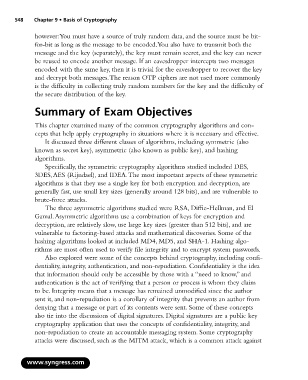Page 564 - StudyBook.pdf
P. 564
548 Chapter 9 • Basis of Cryptography
however:You must have a source of truly random data, and the source must be bit-
for-bit as long as the message to be encoded.You also have to transmit both the
message and the key (separately), the key must remain secret, and the key can never
be reused to encode another message. If an eavesdropper intercepts two messages
encoded with the same key, then it is trivial for the eavesdropper to recover the key
and decrypt both messages.The reason OTP ciphers are not used more commonly
is the difficulty in collecting truly random numbers for the key and the difficulty of
the secure distribution of the key.
Summary of Exam Objectives
This chapter examined many of the common cryptography algorithms and con-
cepts that help apply cryptography in situations where it is necessary and effective.
It discussed three different classes of algorithms, including symmetric (also
known as secret key), asymmetric (also known as public key), and hashing
algorithms.
Specifically, the symmetric cryptography algorithms studied included DES,
3DES,AES (Rijndael), and IDEA.The most important aspects of these symmetric
algorithms is that they use a single key for both encryption and decryption, are
generally fast, use small key sizes (generally around 128 bits), and are vulnerable to
brute-force attacks.
The three asymmetric algorithms studied were RSA, Diffie-Hellman, and El
Gamal.Asymmetric algorithms use a combination of keys for encryption and
decryption, are relatively slow, use large key sizes (greater than 512 bits), and are
vulnerable to factoring-based attacks and mathematical discoveries. Some of the
hashing algorithms looked at included MD4, MD5, and SHA-1. Hashing algo-
rithms are most often used to verify file integrity and to encrypt system passwords.
Also explored were some of the concepts behind cryptography, including confi-
dentiality, integrity, authentication, and non-repudiation. Confidentiality is the idea
that information should only be accessible by those with a “need to know,” and
authentication is the act of verifying that a person or process is whom they claim
to be. Integrity means that a message has remained unmodified since the author
sent it, and non-repudiation is a corollary of integrity that prevents an author from
denying that a message or part of its contents were sent. Some of these concepts
also tie into the discussions of digital signatures. Digital signatures are a public key
cryptography application that uses the concepts of confidentiality, integrity, and
non-repudiation to create an accountable messaging system. Some cryptography
attacks were discussed, such as the MITM attack, which is a common attack against
www.syngress.com

